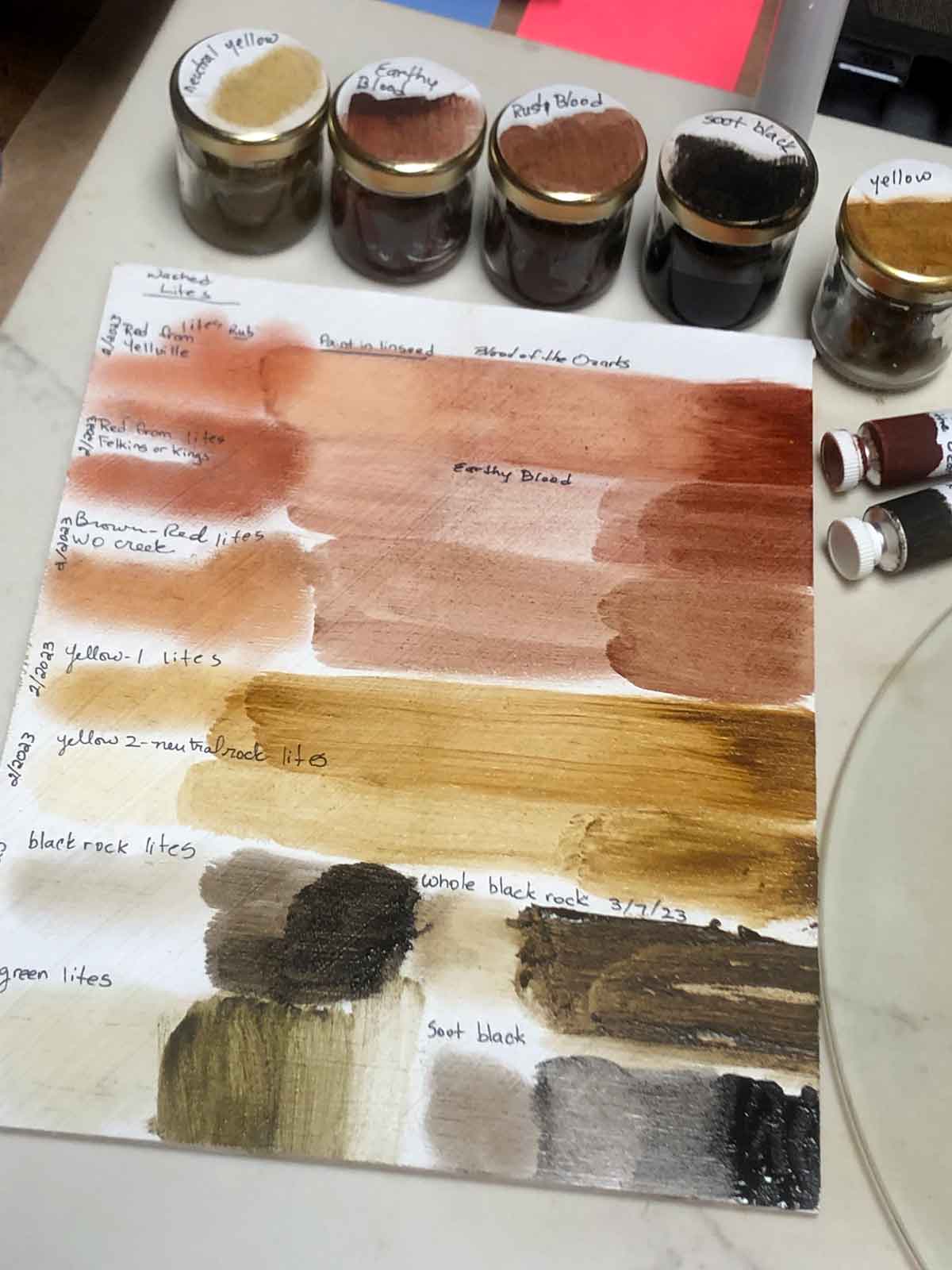For the past few days I’ve had to make a detour from my Detour for a Thirsty Raven painting. Because my art is made from natural materials, it means I have to take the time to replenish my supplies from time to time. So, I’ve been washing pigments and making paint. Besides, the layers of paint already on the board needed to dry anyway, before I can add more layers.
Permanent Natural Colors
Some art made from natural materials is ephemeral. Almost all of the plant-based pigments I’ve tried fall into this category. I’d have a much larger range of colors, at least in watercolor if this was an avenue I wanted to pursue. But I like the idea of my colors being the same in 100 years as they were when the brush stroke left them on my canvas when I created the artwork. And so, I use the earth pigments with staying power for the bulk of my work.
And sometimes the art is itself is made from materials gathered in nature, but simply arranged and not processed into another form. I use facets of both in my artwork, but for the paintings, it is a process that transforms the material into a pigment that can then be used to create a painting. When I am making something else, like sculptures or decorating my paint tins, I often use botanical things like preserved leaves or twigs and grasses as part of the art or presentation.
Palette of Permanent Color
Here’s the colors I made this week. These are oil paints. I make the paints with linseed oil, and when I’m using them on the canvas/board, I mix with walnut oil. All of my cleanup is done with oil, too, since I am trying to avoid the harsh chemicals like turpentine or thinners.
I’m going to need black, mainly, to finish the raven in my current painting. But it’s a mess to make the paint, so whenever I make one color, I usually make as many as I can. This way I can get all of the mess-making done and cleaned in one day.

Reds
The three different shades of red are from three different rocks. The top, reddest red is from a rock found near Yellville, AR. The next two lived in the creek here at Wild Ozark. The red from the top rock is the rarest red of all. I do find small pieces of it here at home, but it’s hard to find them without yellow or shale mixed in.
Yellows
Two different rocks made these yellows. The first one was a very earthy yellow sandstone. The second was almost white and I hoped for a lighter color than what it yielded. But if I apply a thin layer and wipe it off, it will work as a nice tint that might work as a glaze. What I really wanted was something to use in place of white, but it will not do for that. So I’ll still need the outsourced titanium powder for that.
Black
The first black came from a black rock. When I crush the rock, there is a smell of tar. So I think it is a bituminous rock. The whole rock gives a brownish, and when I wash it and use just the lites I get a nice black. The second black at the bottom right is from soot that I collected from our chimney. This is a deep black, and what I needed to finish my painting.
Green
This is as close to green I’ve found in a permanent color. It comes from a grayish-green siltstone or mudstone that I find here at Wild Ozark.

In Progress
Detour for a Thirsty Raven is the painting in progress that needed the blackest black I could make. Now I can work on finishing it!
ABOUT
________________________________
Madison Woods is the pen-name for my creative works. I’m a self-taught artist who moved to the Ozarks from south Louisiana in 2005. My paintings of Ozark-inspired scenes feature lightfast pigments from Madison county, Arkansas. My inspiration is nature – the beauty, and the inherent cycle of life and death, destruction, regeneration, and transformation.
Roxann Riedel is my real name. I’m also salesperson for Montgomery Whiteley Realty. If you’re interested in buying or selling in Madison or Carroll county, AR, let me know! You can see the properties that I blog about at WildOzarkLand.com.
Wild Ozark is also the only licensed ginseng nursery in Arkansas. Here’s the link for more information on the nursery
P.S.
There’s always a discount for paintings on the easel 😉
Here’s my Online Portfolio
And, Click here to join my mailing list.
Contact Mad Rox: (479) 409-3429 or madison@madisonwoods and let me know which hat I need to put on 🙂 Madison for art, Roxann for real estate, lol. Or call me Mad Rox and have them both covered!
https://www.youtube.com/@wildozark



Leave a Reply